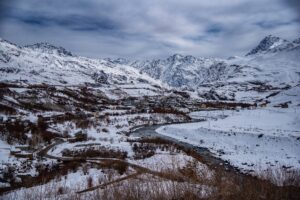When most people think about Ladakh in the winter, they imagine soft, absolutely white snow swaying through the air and falling softly on the ground, only to make it onto a thick, untouched light blanket of what looks like clouds. “Beautiful” and “enchanting” are two words that perfectly describe the visual landscape of the place. However, what gets hidden behind this beauty is an extremely cumbersome life.
Winter in Ladakh has always been very hard on its people, but what is commendable is how they have navigated and adapted to sustain life in its most exhilarating form during this time. Traditionally, households in Ladakh start preparing for the winter soon after the harvest season. They braid their onions into bunches, puree their tomatoes, store away potatoes, stock up on rich grains like barley, dry their greens, churn lots of butter, and shift into the small, cold winter kitchen. The “gun-khang” or winter kitchen would be a room with a very low ceiling, no windows, and a small chimney—a space that would serve as an ideal pantry and kitchen for the harsh winter. Most households would also dry and hang at least one animal for the winter to serve as a source of protein for the family. Pieces of this dry meat would also be seasoned and carried around in pockets by people to snack on throughout the day.


Other than the food, people also collect and chop wood and dung for putting into “thaps,” the traditional metal stove, and “bukharis,” the Kashmiri fireplace.
The winter, although hard, also serves as a time for people to come together. A lot of the festivals that are celebrated in Ladakh happen during the winter. Losar, for instance, is the Ladakhi Buddhist New Year, and it is celebrated in either December or January, depending on the lunar calendar. This is a festival that equates perfectly with Diwali for the Hindus of the Indian mainland or Eid for the Islamic population. It is a time to come together as a family, to be social, and to visit neighbors and relatives—to essentially reconnect. The winter is also the time for what can only be explained as Ladakh’s “carnivals.” These are two-day affairs run by monasteries of different villages, performing ceremonies symbolizing cleansing for the year called “gustors.” Each village has its own narratives, specific performative rituals, and presentations. It is important to remember here that these festivals take place in freezing temperatures, mostly outdoors, and are still full of life.
The Ladakhi people adapted to find strength and warmth in a community, and I think that is what winter in Ladakh is really about. It is a reminder of the impermanence of summer, but like Antoine de Saint-Exupéry wrote in “The Little Prince,” “What makes the desert beautiful is that somewhere it hides a well…” and for Ladakh, its “well” is simply acts like replanting flowers every spring, knowing that they would inevitably die in the winter, and still starting over at the beginning of every year.